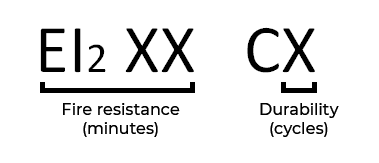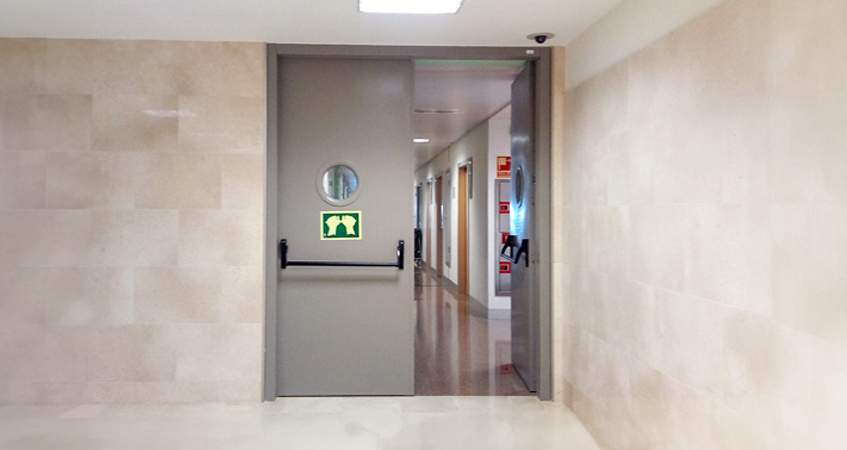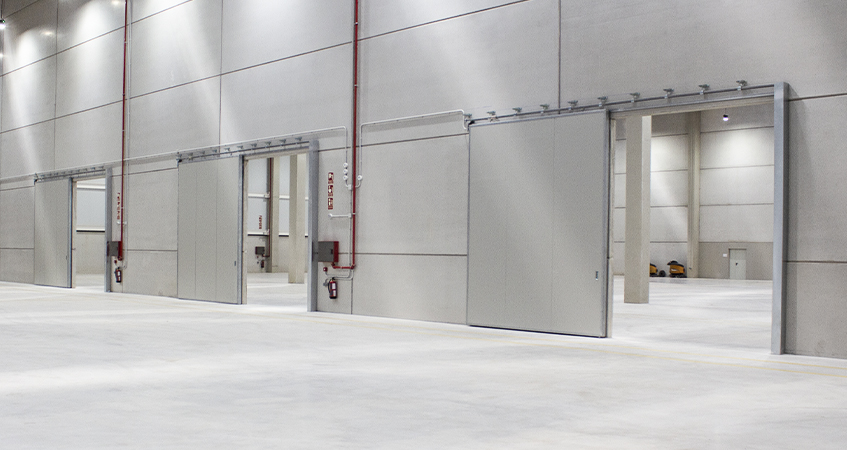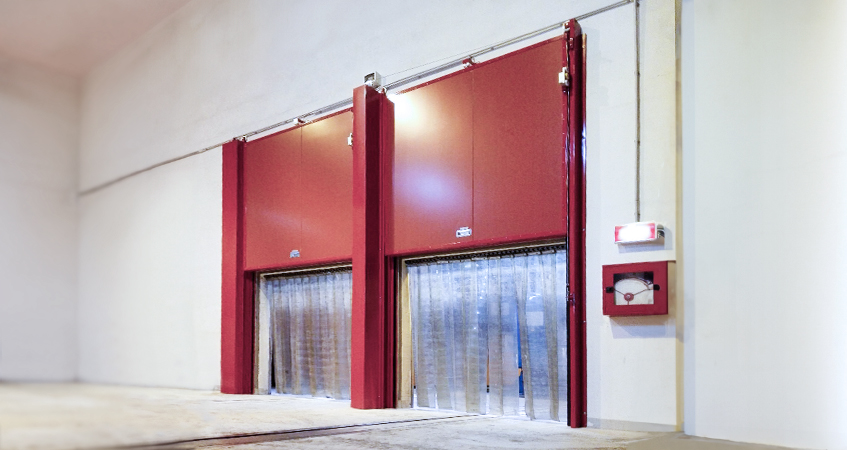How are fire doors classified? What model do I need? Whether they are pedestrian, industrial, or garage doors, there are a series of indicators that we must pay special attention to in order to meet the requirements demanded for each type of door.
Fire door regulations
Since November 1st, 2016, European standards that include the requirements for fire-resistant and/or smoke control doors are included in regulations EN 16034, EN 14351-1, and EN 13241, and compliance is mandatory.
CE marking
This regulation will also require the CE marking of products included in it from 1/09/2019 onwards. Before that date, both the European system (CE marking) and the national system can coexist.

Building Technical Code
These are the minimum requirements that fire doors must meet according to the Building Technical Code:
- Having a fire resistance test according to UNE-EN1.634-1, and a classification of EI2 (t) according to UNE-EN 13.501-2. (t) = classification time: 30, 60, 90 or 120 minutes.
- Having a durability test for self-closing according to UNE-EN1.191 and a classification of C5 (200,000 cycles) according to EN 14.600.
- Incorporating hinges without spring and with CE marking.
- Impossibility to install fire-resistant glass. Fireproof glass must be used instead.
- Incorporating a door closer with CE marking, except in access panels.
- Incorporating a CE-marked latch selector (with appropriate digits 1) on double-canvas doors.
- Fire doors must incorporate locks with CE marking
- Panic bars must carry the CE marking.
- Electromagnets must carry the CE marking.
Classification of fire doors
There are two main indicators determined through testing that fire doors undergo, which will allow us to establish their classification according to their fire resistance (EI2) and durability (C).
El2 XXC: Fire resistance (minutes)
X: Durability (cycles)

Fire resistance (EN 1634-1)
The objective of determining fire resistance is to assess the behavior of the sample when subjected to defined conditions of heating and pressure.
The “I” factor can be measured and classified in two ways, represented by subscripts 1 and 2, depending on the different European national regulations. Spanish regulation requires EI2.
In this way, we can classify fire doors according to their fire resistance time (measured in minutes) as: EI2 60, EI2 90, EI2 120, etc.
The standardized time scale according to the new UNE is 15, 30, 45, 60, 90, 120, 180, and 240 minutes.
Durability of automatic closing
The automatic closing (C) is the ability of a door to fully close in the frame and engage the locking device.
The results are classified according to the EN 13501-2 standard and expressed with a “C”, followed by a digit between 0 and 5, which is determined by the number of cycles in the test.
| Use category | Cycles |
|---|---|
| 5 | ≥ 200.000 |
| 4 | ≥ 100.000 |
| 3 | ≥ 50.000 |
| 2 | ≥ 10.000 |
| 1 | ≥ 500 |
| 0 | 1 a 499 |
Fire door models
Once the main indicators are defined, let’s take a look at the models available in Kavidoors, along with their corresponding indicators:
Standard hinged fire doors:
This door is designed for use in residential and public buildings where reliability and competitiveness are paramount.

| Available classifications EL2 | Durability | Versions |
|---|---|---|
| 45/60/90/120 | c5 | 1 and 2 sheets |
This range of doors has been tested with a wide range of hardware: handles, door closers, selectors, panic bars, fire-resistant glass, etc., and comes in multiple finishes.
At Kavidoors we have several models of hinged fire doors.
Sliding fire doors:

Sliding fire doors are doors that slide horizontally along a rail and, due to their characteristics, allow for constructions of large dimensions.
The most common use of sliding fire doors is in areas where they should normally remain open, so they have an electromagnetic retention system. Once the door closing system is activated (a fire detection signal cuts off the power supply), the counterweight system will cause the door to close.
Kavidoors’ sliding fire doors are the best solution for compartmentalization in both industrial areas and public buildings.
| Available classifications EL2 | Versions | ||
|---|---|---|---|
| 60/120 | 1 sheet with side opening | 2 sheets with center closure | 2 telescopic sheets |
Vertical sliding fire doors (guillotine):

Guillotine fire doors are the best solution for compartmentalization in industrial areas, especially in places where the available headroom favors this alternative.
This type of door is designed to remain open, retained by the action of an electromagnet, which, in case of a fire signal, the building’s alarm system automatically unlocks. The controlled closure is produced by the action of the counterweight system.
| Available classifications EL2 | Versions |
|---|---|
| 120 | 1 sheet with vertical opening |
Other options of fire doors: glazed and special doors:
Fire protection requirements reach a higher quality when structural elements have a sophisticated design.
Do you already know what fire door you need?
If you are already clear on what fire door you need, request your quote without any obligation.
If not, please contact us and our technical team will answer your questions.
At Kavidoors, we provide your business with safer fire doors thanks to PIR foam, which guarantees exceptional sealing while protecting the facilities in case of fire. In all of our doors, we use a sandwich with the insulating core made of this material.
What is PIR foam?
PIR is a polyisocyanurate polyurethane foam with excellent qualities, including resistance to moisture as it does not absorb water, resistance to fire, or its high insulating capacity, which is 10% greater than conventional materials. Additionally, it tolerates chemicals well, which prevents the growth of fungi or bacteria inside.
How does it react when a fire occurs?
If a fire occurs in the facilities, PIR foam prevents fire penetration into the interior layers of the foam, protecting them by forming a carbonaceous mesh that slowly breaks down at temperatures of 1200°. This does not mean that it is fireproof, but it does aid in extinguishing efforts and delays its spread.
Additionally, it is noteworthy that PIR foam does not drip, carbonizes to a lesser extent, and generates less smoke compared to other materials such as PUR foam or EPS. Since it does not propagate flame, the damage is much less in a fire. Therefore, not only food, health, and logistics industries are interested in PIR, but also insurance companies.
Testing of different materials against fire
Next, we show you a test carried out to check the behavior of PIR foam against fire, comparing it with PUR and EPS foam.
As observed in the test, EPS foam yields to fire and drips but emits practically no smoke. On the other hand, PUR foam resists fire but ends up carbonized, does not drip and expels large amounts of black smoke. In contrast, PIR foam is the material that offers the most resistance to fire and generates less smoke compared to the others, besides hardly dripping.
Ready to find the perfect fire door for your needs?
Get in touch for a quote with no strings attached! Our expert team is here to help with any questions you have.





